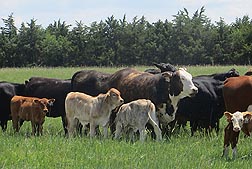This page has been archived and is being provided for reference purposes only. The page is no longer being updated, and therefore, links on the page may be invalid.
| Read the magazine story to find out more. |
|
|
"2,000 Bull Project" Targets Cattle Traits
By Sandra Avant
September 15, 2014
U.S. Department of Agriculture (USDA) scientists are investigating methods to help beef cattle producers further improve genetic evaluations for routinely measured traits such as growth and calving ease. They are also targeting economically important traits like feed efficiency and disease resistance that are expensive or difficult to measure.
In 2007, scientists started the "2,000 Bull Project" at the Agricultural Research Service (ARS) Roman L. Hruska U.S. Meat Animal Research Center (USMARC) in Clay Center, Nebraska, to study relationships between genomic variation and economically important traits in 16 breeds. ARS is USDA's principal intramural scientific research agency, and this research supports the USDA priority of promoting international food security.
USMARC geneticists Mark Thallman and Larry Kuehn and their colleagues worked with U.S. cattle breed associations to obtain genomic profiles of 2,000 bulls from those 16 breeds to promote the development of genomic predictions. For each breed, the project provided the first substantial set of high-density genotypes, which are being used by breed associations as a starting point to incorporate genomic data into their breed improvement programs.
Growth is a routine and easily measured trait that is related to increased feed consumption, but an animal's feed efficiency-how much feed is required to produce a unit of growth-is more economically important to producers. However, individual feed intake is not practical to measure on large numbers of animals in commercial operations. Instead, a more feasible approach is to use research populations to develop genomic predictions for traits such as individual feed intake, disease resistance and meat tenderness that are expensive or difficult to measure.
At USMARC, thousands of cattle have been evaluated for such traits, and about 15,000 have been genotyped. The researchers' goal is to detect genomic regions that affect these traits to improve the accuracy of genomic tests available to producers. Also, the scientists are sequencing the genomes of bulls that have the most descendants in the USMARC population, which may lead to more accurate predictions across breeds and benefit the industry.
As part of this effort, geneticist Warren Snelling is focusing on identifying DNA sequence variation that affects gene function to help predict important traits consistently across many breeds. Snelling has demonstrated that this technique can be used to identify genetic markers predictive of meat tenderness.
Read more about this research in the September 2014 issue of Agricultural Research magazine.

